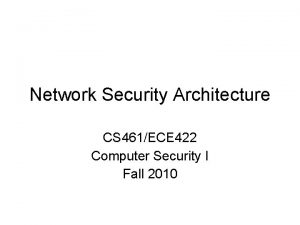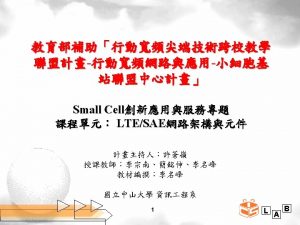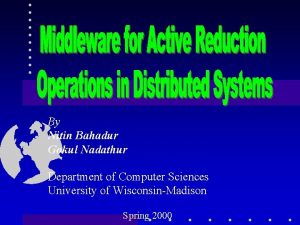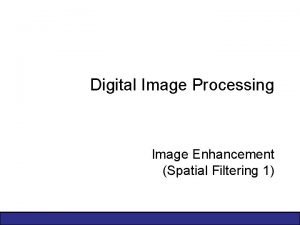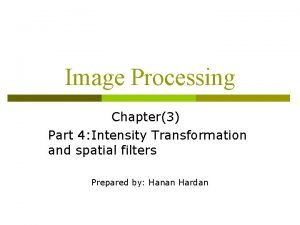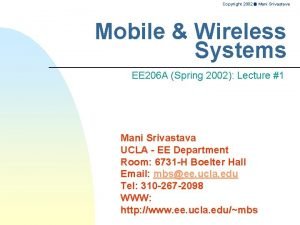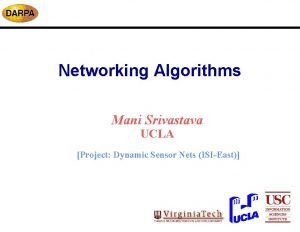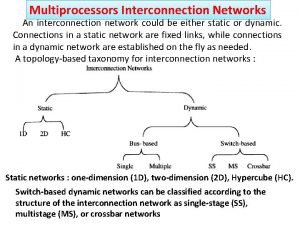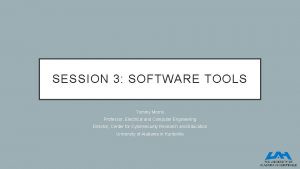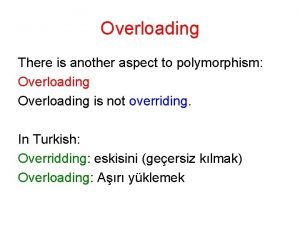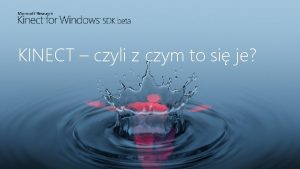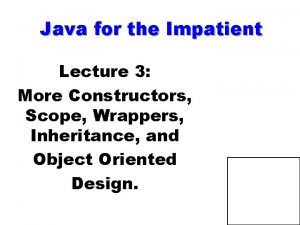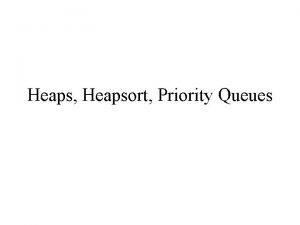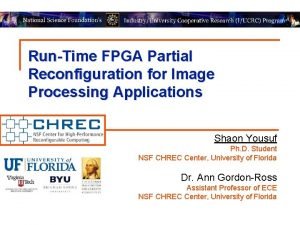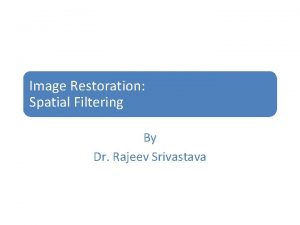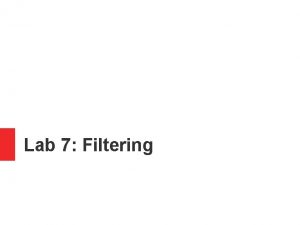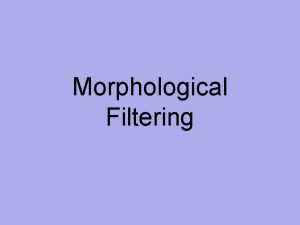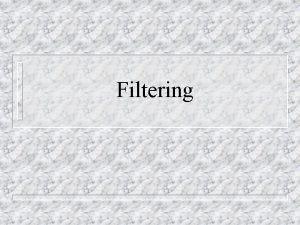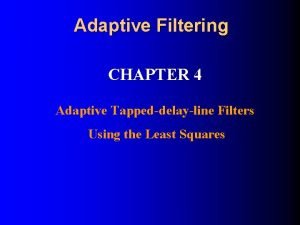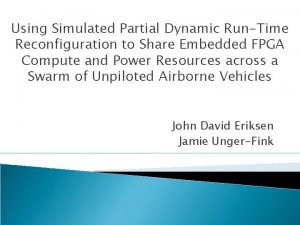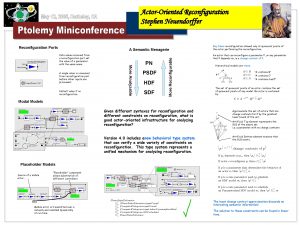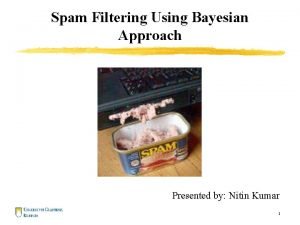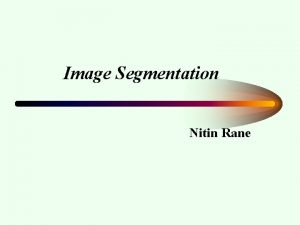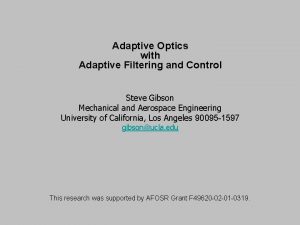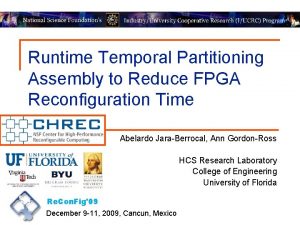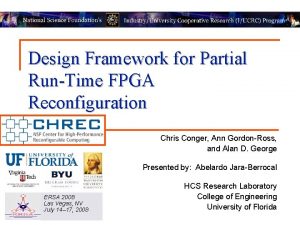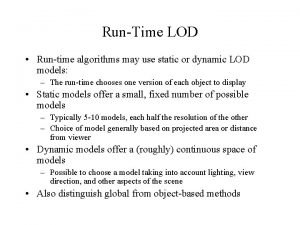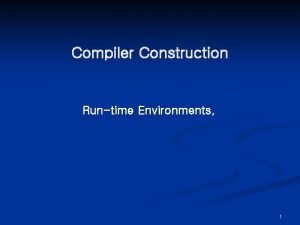Adaptive Image Filtering Using RunTime Reconfiguration Nitin Srivastava















![v[7, 23] 0 0 pd[8, 24, -1] v[7, 25] v[7, 24] 0 0 pd[8, v[7, 23] 0 0 pd[8, 24, -1] v[7, 25] v[7, 24] 0 0 pd[8,](https://slidetodoc.com/presentation_image_h2/d0391f3cd0d041e3bbd02990a9b4d872/image-16.jpg)

![v[7, 23] 0 0 pd[8, 24, -1] pd[8, 23, -1, 0] v[7, 25] v[7, v[7, 23] 0 0 pd[8, 24, -1] pd[8, 23, -1, 0] v[7, 25] v[7,](https://slidetodoc.com/presentation_image_h2/d0391f3cd0d041e3bbd02990a9b4d872/image-18.jpg)
![block memory block memories block memory 9 rs(-1)[8, 24] 5, 22 5, 23 5, block memory block memories block memory 9 rs(-1)[8, 24] 5, 22 5, 23 5,](https://slidetodoc.com/presentation_image_h2/d0391f3cd0d041e3bbd02990a9b4d872/image-19.jpg)
![v[7, 23] 0 0 pd[8, 24, -1] pd[8, 23, -1, 0] pd[8, 23, -1, v[7, 23] 0 0 pd[8, 24, -1] pd[8, 23, -1, 0] pd[8, 23, -1,](https://slidetodoc.com/presentation_image_h2/d0391f3cd0d041e3bbd02990a9b4d872/image-20.jpg)
![block memory 11 block memories block memory 9 newv[6, 24] rs(-1)[8, 24] rs(-1)[7. 24]+ block memory 11 block memories block memory 9 newv[6, 24] rs(-1)[8, 24] rs(-1)[7. 24]+](https://slidetodoc.com/presentation_image_h2/d0391f3cd0d041e3bbd02990a9b4d872/image-21.jpg)
![v[7, 23] 0 0 pd[8, 24, -1] pd[8, 23, -1, 0] pd[8, 23, -1, v[7, 23] 0 0 pd[8, 24, -1] pd[8, 23, -1, 0] pd[8, 23, -1,](https://slidetodoc.com/presentation_image_h2/d0391f3cd0d041e3bbd02990a9b4d872/image-22.jpg)


![v[6, 23] 0 0 pd[7, 24, -1] v[6, 25] v[6, 24] 0 pd[7, 25, v[6, 23] 0 0 pd[7, 24, -1] v[6, 25] v[6, 24] 0 pd[7, 25,](https://slidetodoc.com/presentation_image_h2/d0391f3cd0d041e3bbd02990a9b4d872/image-25.jpg)
![v[6, 23] 0 0 pd[7, 24, -1] pd[7, 23, -1, 0] v[6, 25] v[6, v[6, 23] 0 0 pd[7, 24, -1] pd[7, 23, -1, 0] v[6, 25] v[6,](https://slidetodoc.com/presentation_image_h2/d0391f3cd0d041e3bbd02990a9b4d872/image-26.jpg)
![v[6, 23] 0 0 pd[7, 24, -1] v[6, 25] v[6, 24] 0 pd[7, 25, v[6, 23] 0 0 pd[7, 24, -1] v[6, 25] v[6, 24] 0 pd[7, 25,](https://slidetodoc.com/presentation_image_h2/d0391f3cd0d041e3bbd02990a9b4d872/image-27.jpg)
![v[8, 23] 0 0 pd[9, 24, -1] v[8, 25] v[8, 24] 0 0 pd[9, v[8, 23] 0 0 pd[9, 24, -1] v[8, 25] v[8, 24] 0 0 pd[9,](https://slidetodoc.com/presentation_image_h2/d0391f3cd0d041e3bbd02990a9b4d872/image-28.jpg)


- Slides: 30

Adaptive Image Filtering Using Run-Time Reconfiguration Nitin Srivastava Jerry L. Trahan Ramachandran Vaidyanathan Suresh Rai Department of Electrical and Computer Engineering Louisiana State University

The Problem: Adaptive Image Filtering • A filtering window moves over the image pixel by pixel. Window size is usually 3 3, 5 5, or 7 7. • The filter multiplies the intensity values of pixels that the window overlaps with its coefficients and sums the products to produce the new value of the pixel at the center of the window.

Working of a 3 3 size filter

• Spatially invariant filter — does not change values of its coefficients with the position of the filtering window over the image. • Adaptive filter — adjusts values of its coefficients according to the nature of the image. For instance, handles uniform regions differently than edges.

Use of Run-Time Reconfiguration • For fixed filter coefficients, could use constant coefficient multipliers (KCMs) configured for coefficients. • For adaptive coefficients, we use KCMs configured for pixel values. Flow of data regular, but more involved. • Inspired by 1 D adaptive filtering technique of Wojko and El. Gindy (RAW’ 99).

Use of FPGAs • Circuit design tailored to the problem — Filtering exhibits regular, repeated operations, taking an inner product among the same number of elements at each pixel position. • Problem size-specific components and datapaths. • Advantages for this problem even without reconfiguration.

Image Filtering Details

Solution Approach • Gray scale image of size 256, using a filtering window of size 3 3. • Can tailor to different image size — changes some register sizes and memory requirements. • Can tailor to different window size — changes memory requirements. • Can extend to video — window is 3 D across frames.

Solution Approach, cont. • Basic component is a module. • Sixteen pipelined modules act on 16 contiguous pixels at a time from the same row. • Three sets of three steps each, corresponding to the three rows in a 3 3 window and the three positions in each row. • For each of these nine steps, a module contributes to one of the nine window computations in which its pixel participates.

Module Algorithm Procedure Step 0: Step 1: Step 2: THREEPIX(r, in, out) Adder(r) KCM(r) + in Adder(r) KCM(r) + Adder(r 1) out Adder(r) • Contributes to three pixel values on the same row.

Overall Algorithm for i 0 to 255 for k 0 to 255 in steps of 16 for all j, where k j k+15 r = j mod 16 /* module r has v(i, j) */ THREEPIX(r, 0, memory) THREEPIX(r, memory, I/O pins)

Module filtering window pixel coefficient value KCM zero register 0 To output mux KCM To block memory write register module mux previous module memory read register From block memory KCM output mux pipeline register module adder step counter next module

First vantage point: one module

5, 22 5, 23 5, 24 5, 25 5, 26 5, 27 5, 28 5, 29 6, 22 6, 23 6, 24 6, 25 6, 26 6, 27 6, 28 6, 29 7, 22 7, 23 7, 24 7, 25 7, 26 7, 27 7, 28 7, 29 8, 22 8, 23 8, 24 8, 25 8, 26 8, 27 8, 28 8, 29 9, 22 9, 23 9, 24 9, 26 9, 27 9, 28 9, 29 9, 25

block memory block memories block memory 5, 22 5, 23 5, 24 5, 25 5, 26 5, 27 5, 28 5, 29 6, 22 6, 23 6, 24 6, 25 6, 26 6, 27 6, 28 6, 29 7, 22 7, 23 7, 24 7, 25 7, 26 7, 27 7, 28 7, 29 8, 22 8, 23 8, 24 8, 26 8, 27 8, 28 8, 29 9, 22 9, 23 9, 24 9, 26 9, 27 9, 28 9, 29 8, 25 9, 25
![v7 23 0 0 pd8 24 1 v7 25 v7 24 0 0 pd8 v[7, 23] 0 0 pd[8, 24, -1] v[7, 25] v[7, 24] 0 0 pd[8,](https://slidetodoc.com/presentation_image_h2/d0391f3cd0d041e3bbd02990a9b4d872/image-16.jpg)
v[7, 23] 0 0 pd[8, 24, -1] v[7, 25] v[7, 24] 0 0 pd[8, 25, -1] v[7, 26] pd[8, 26, -1] pd[8, 27, -1] pd[8, 26, -1, 0] v[7, 27] 0 pd[8, 28, -1]

Nitin: block memory Slide added block memories block memory 5, 22 5, 23 5, 24 5, 25 5, 26 5, 27 5, 28 5, 29 6, 22 6, 23 6, 24 6, 25 6, 26 6, 27 6, 28 6, 29 7, 22 7, 23 7, 24 7, 25 7, 26 7, 27 7, 28 7, 29 8, 22 8, 23 8, 24 8, 26 8, 27 8, 28 8, 29 9, 22 9, 23 9, 24 9, 26 9, 27 9, 28 9, 29 8, 25 9, 25
![v7 23 0 0 pd8 24 1 pd8 23 1 0 v7 25 v7 v[7, 23] 0 0 pd[8, 24, -1] pd[8, 23, -1, 0] v[7, 25] v[7,](https://slidetodoc.com/presentation_image_h2/d0391f3cd0d041e3bbd02990a9b4d872/image-18.jpg)
v[7, 23] 0 0 pd[8, 24, -1] pd[8, 23, -1, 0] v[7, 25] v[7, 24] 0 0 pd[8, 25, -1] pd[8, 24, -1, 0] v[7, 26] pd[8, 26, -1] pd[8, 25, -1, 0] pd[8, 27, -1] pd[8, 26, -1, 0] pd[8, 25, -1, 1] v[7, 27] 0 pd[8, 28, -1] pd[8, 27, -1, 0]
![block memory block memories block memory 9 rs18 24 5 22 5 23 5 block memory block memories block memory 9 rs(-1)[8, 24] 5, 22 5, 23 5,](https://slidetodoc.com/presentation_image_h2/d0391f3cd0d041e3bbd02990a9b4d872/image-19.jpg)
block memory block memories block memory 9 rs(-1)[8, 24] 5, 22 5, 23 5, 24 5, 25 5, 26 5, 27 5, 28 5, 29 6, 22 6, 23 6, 24 6, 25 6, 26 6, 27 6, 28 6, 29 7, 22 7, 23 7, 24 7, 25 7, 26 7, 27 7, 28 7, 29 8, 22 8, 23 8, 24 8, 26 8, 27 8, 28 8, 29 9, 22 9, 23 9, 24 9, 26 9, 27 9, 28 9, 29 8, 25 9, 25
![v7 23 0 0 pd8 24 1 pd8 23 1 0 pd8 23 1 v[7, 23] 0 0 pd[8, 24, -1] pd[8, 23, -1, 0] pd[8, 23, -1,](https://slidetodoc.com/presentation_image_h2/d0391f3cd0d041e3bbd02990a9b4d872/image-20.jpg)
v[7, 23] 0 0 pd[8, 24, -1] pd[8, 23, -1, 0] pd[8, 23, -1, 1] v[7, 25] v[7, 24] 0 0 pd[8, 25, -1] v[7, 26] pd[8, 26, -1] pd[8, 27, -1] v[7, 27] 0 pd[8, 28, -1] pd[8, 24, -1, 0] pd[8, 25, -1, 0] pd[8, 26, -1, 0] pd[8, 27, -1, 0] pd[8, 22, -1, 1] pd[8, 24, -1, 1] pd[8, 25, -1, 1] rs(-1)[8, 24] pd[8, 26, -1, 1]
![block memory 11 block memories block memory 9 newv6 24 rs18 24 rs17 24 block memory 11 block memories block memory 9 newv[6, 24] rs(-1)[8, 24] rs(-1)[7. 24]+](https://slidetodoc.com/presentation_image_h2/d0391f3cd0d041e3bbd02990a9b4d872/image-21.jpg)
block memory 11 block memories block memory 9 newv[6, 24] rs(-1)[8, 24] rs(-1)[7. 24]+ rs(0)[7, 24] rs(-1)[7, 26] rs(-1)[6, 26]+ rs(0)[6. 26] 5, 22 5, 23 5, 24 5, 25 5, 26 5, 27 5, 28 5, 29 6, 22 6, 23 6, 24 6, 25 6, 26 6, 27 6, 28 6, 29 7, 22 7, 23 7, 24 7, 25 7, 26 7, 27 7, 28 7, 29 8, 22 8, 23 8, 24 8, 26 8, 27 8, 28 8, 29 9, 22 9, 23 9, 24 9, 26 9, 27 9, 28 9, 29 8, 25 9, 25
![v7 23 0 0 pd8 24 1 pd8 23 1 0 pd8 23 1 v[7, 23] 0 0 pd[8, 24, -1] pd[8, 23, -1, 0] pd[8, 23, -1,](https://slidetodoc.com/presentation_image_h2/d0391f3cd0d041e3bbd02990a9b4d872/image-22.jpg)
v[7, 23] 0 0 pd[8, 24, -1] pd[8, 23, -1, 0] pd[8, 23, -1, 1] pd[7, 24, 0, -1] v[7, 25] v[7, 24] 0 0 pd[8, 25, -1] pd[8, 24, -1, 0] pd[8, 22, -1, 1] rs(-1)[7, 26] pd[7, 25, 0, -1] v[7, 26] pd[8, 26, -1] pd[8, 27, -1] v[7, 27] 0 pd[8, 28, -1] pd[8, 25, -1, 0] pd[8, 26, -1, 0] pd[8, 27, -1, 0] pd[8, 24, -1, 1] pd[8, 25, -1, 1] rs(-1)[8, 24] pd[7, 27, 0, -1] pd[8, 26, -1, 1] pd[7, 25, 0, 0] pd[7, 26, 0, 0] pd[7, 27, 0, 0] pd[7, 24, 0, 1] pd[7, 25, 0, 1] pd[7, 26, 0, 1] rs(-1)[7, 24]+rs(0)[7, 24] pd[6, 27, 1, -1] pd[6, 28, 1, -1] pd[7, 26, 0, -1] pd[7, 28, 0, -1] pd[6, 24, 1, -1] pd[7, 24, 0, 0] pd[7, 23, 0, 1] rs(-1)[6, 26]+ rs(0)[6, 26] pd[6, 25, 1, -1] pd[6, 26, 1, -1] pd[6, 23, 1, 0] pd[6, 24, 1, 0] pd[6, 25, 1, 0] pd[6, 26, 1, 0] pd[6, 27, 1, 0] pd[6, 24, 1, 1] pd[6, 25, 1, 1] pd[6, 26, 1, 1] pd[7, 23, 0, 0] pd[7, 22, 0, 1] pd[6, 22, 1, 1] pd[6, 23, 1, 1] newv[6, 24]

Second vantage point: one pixel

5, 22 5, 23 5, 24 5, 25 5, 26 5, 27 5, 28 5, 29 6, 22 6, 23 6, 24 6, 25 6, 26 6, 27 6, 28 6, 29 7, 22 7, 23 7, 24 7, 25 7, 26 7, 27 7, 28 7, 29 8, 22 8, 23 8, 24 8, 25 8, 26 8, 27 8, 28 8, 29 9, 22 9, 23 9, 24 9, 26 9, 27 9, 28 9, 29 9, 25
![v6 23 0 0 pd7 24 1 v6 25 v6 24 0 pd7 25 v[6, 23] 0 0 pd[7, 24, -1] v[6, 25] v[6, 24] 0 pd[7, 25,](https://slidetodoc.com/presentation_image_h2/d0391f3cd0d041e3bbd02990a9b4d872/image-25.jpg)
v[6, 23] 0 0 pd[7, 24, -1] v[6, 25] v[6, 24] 0 pd[7, 25, -1] v[6, 26] 0 pd[7, 26, -1] v[6. 27] 0 pd[7, 27, -1] pd[7, 28 – 1, -1]
![v6 23 0 0 pd7 24 1 pd7 23 1 0 v6 25 v6 v[6, 23] 0 0 pd[7, 24, -1] pd[7, 23, -1, 0] v[6, 25] v[6,](https://slidetodoc.com/presentation_image_h2/d0391f3cd0d041e3bbd02990a9b4d872/image-26.jpg)
v[6, 23] 0 0 pd[7, 24, -1] pd[7, 23, -1, 0] v[6, 25] v[6, 24] 0 pd[7, 25, -1] pd[7, 24, -1, 0] v[6, 26] 0 pd[7, 26, -1] pd[7, 25, -1, 0] pd[7, 27, -1] pd[7, 26, -1, 0] v[6. 27] 0 pd[7, 28, -1] pd[7, 27, -1, 0]
![v6 23 0 0 pd7 24 1 v6 25 v6 24 0 pd7 25 v[6, 23] 0 0 pd[7, 24, -1] v[6, 25] v[6, 24] 0 pd[7, 25,](https://slidetodoc.com/presentation_image_h2/d0391f3cd0d041e3bbd02990a9b4d872/image-27.jpg)
v[6, 23] 0 0 pd[7, 24, -1] v[6, 25] v[6, 24] 0 pd[7, 25, -1] v[6, 26] v[6. 27] 0 pd[7, 26, -1] pd[7, 27, -1] 0 pd[7, 28, -1] pd[7, 23, -1, 0] pd[7, 24, -1, 0] pd[7, 25, -1, 0] pd[7, 26, -1, 0] pd[7, 27, -1, 0] pd[7, 22, -1, 1] pd[7, 23, -1, 1] pd[7, 24, -1, 1] pd[7, 25, -1, 1] pd[7, 26, -1, 1] rs(-1)[7, 25]
![v8 23 0 0 pd9 24 1 v8 25 v8 24 0 0 pd9 v[8, 23] 0 0 pd[9, 24, -1] v[8, 25] v[8, 24] 0 0 pd[9,](https://slidetodoc.com/presentation_image_h2/d0391f3cd0d041e3bbd02990a9b4d872/image-28.jpg)
v[8, 23] 0 0 pd[9, 24, -1] v[8, 25] v[8, 24] 0 0 pd[9, 25, -1] v[8, 26] pd[9, 26, -1] pd[9, 27, -1] v[8, 27] 0 pd[9, 28, -1] pd[9, 23, -1, 0] pd[9, 24, -1, 0] pd[9, 25, -1, 0] pd[9, 26, -1, 0] pd[9, 27, -1, 0] pd[9, 22, -1, 1] pd[9, 23, -1, 1] pd[9, 24, -1, 1] pd[9, 25, -1, 1] pd[9, 26, -1, 1] pd[8, 25, 0, -1] pd[8, 26, 0, -1] pd[8, 27, 0, -1] pd[8, 28, 0, -1] pd[8, 24, 0, 0] pd[8, 25, 0, 0] pd[8, 26, 0, 0] pd[8, 27, 0, 0] pd[8, 22, 0, 1] rs(-1)[7, 25]+ rs(0)[7, 25] pd[8, 23, 0, 1] pd[8, 24, 0, 1] pd[8, 25, 0, 1] pd[8, 26, 0, 1] pd[7, 24, 1, -1] pd[7, 25, 1, -1] pd[7, 26, 1, -1] pd[7, 23, 1, 0] pd[7, 24, 1, 0] pd[8, 24, 0, -1] pd[8, 23, 0, 0] pd[7, 22, 1, 1] pd[7, 23, 1, 1] pd[7, 25, 1, 0] pd[7, 24, 1, 1] pd[7, 27, 1, -1] pd[7, 28, 1, -1] pd[7, 26, 1, 0] pd[7, 27, 1, 0] pd[7, 26, 1, 1] pd[7, 25, 1, 1] newv[7, 25]

Evaluation • • Xilinx Virtex-E FPGA XCV 200 E Number of CLB slices required = 492 Clock frequency = 101. 9 MHz Time spent in filtering a 256 image = 642 s

Comparison System description Running time Speedup 866 Pentium system MHz III 20 ms 31 400 MHz Sun Ultra 5 system 53 ms 84
 Ingress filtering vs egress filtering
Ingress filtering vs egress filtering Rrc security mode command
Rrc security mode command Interface core
Interface core Simple bgp configuration example
Simple bgp configuration example Soft-reconfiguration inbound
Soft-reconfiguration inbound Nitie fire alarm panel
Nitie fire alarm panel Dr nitin pandey sms hospital
Dr nitin pandey sms hospital Nitin bahadur
Nitin bahadur Marketo outage
Marketo outage In digital image processing
In digital image processing Types of spatial filtering in digital image processing
Types of spatial filtering in digital image processing Linear filtering in image processing
Linear filtering in image processing Image filtering
Image filtering Rajeev srivastava iit bhu
Rajeev srivastava iit bhu Mani srivastava
Mani srivastava Data2business marketing
Data2business marketing Divesh srivastava
Divesh srivastava Mani srivastava
Mani srivastava Lara srivastava
Lara srivastava Multiprocessor interconnection networks
Multiprocessor interconnection networks Lara srivastava
Lara srivastava Karan srivastava md
Karan srivastava md Diane srivastava
Diane srivastava Gravitational blood drop
Gravitational blood drop List and explain different subdivisions of run-time memory
List and explain different subdivisions of run-time memory Components of system programming
Components of system programming Openplc runtime
Openplc runtime Difference between compile time and runtime
Difference between compile time and runtime Kinect for windows runtime
Kinect for windows runtime Constructor
Constructor Heapify runtime
Heapify runtime
